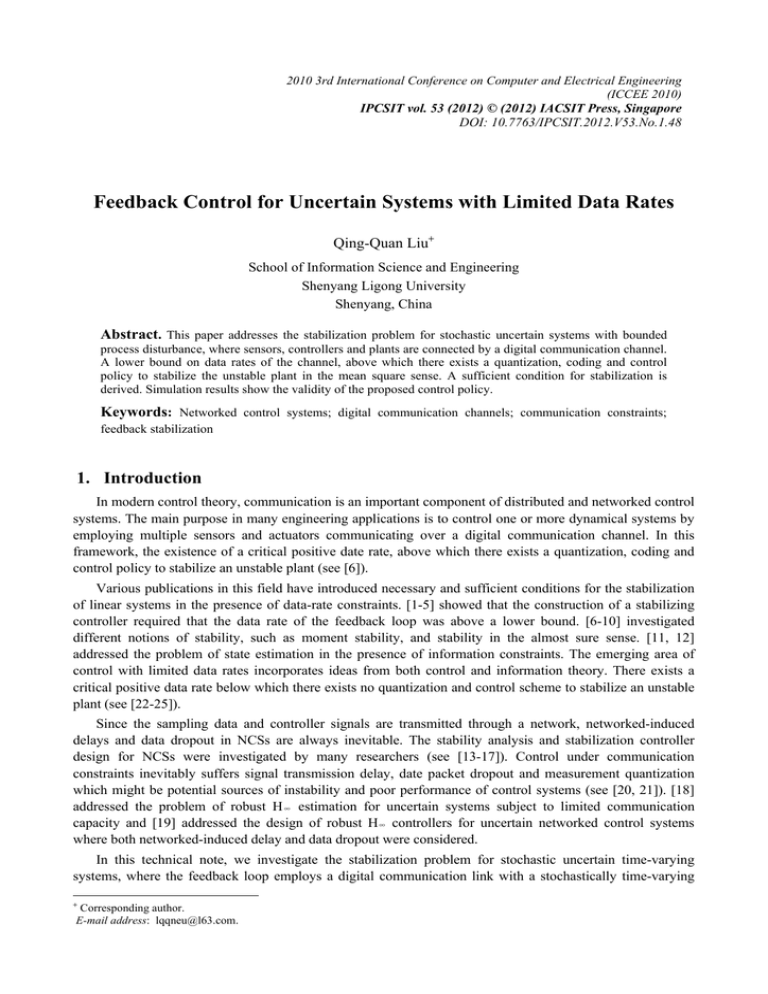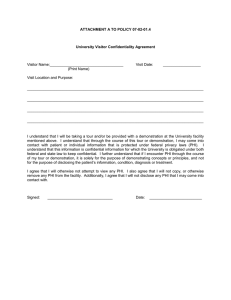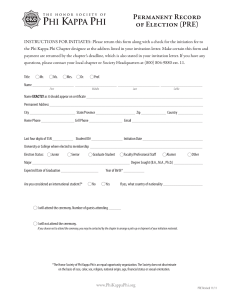Document 13136168
advertisement

2010 3rd International Conference on Computer and Electrical Engineering
(ICCEE 2010)
IPCSIT vol. 53 (2012) © (2012) IACSIT Press, Singapore
DOI: 10.7763/IPCSIT.2012.V53.No.1.48
Feedback Control for Uncertain Systems with Limited Data Rates
Qing-Quan Liu+
School of Information Science and Engineering
Shenyang Ligong University
Shenyang, China
Abstract. This paper addresses the stabilization problem for stochastic uncertain systems with bounded
process disturbance, where sensors, controllers and plants are connected by a digital communication channel.
A lower bound on data rates of the channel, above which there exists a quantization, coding and control
policy to stabilize the unstable plant in the mean square sense. A sufficient condition for stabilization is
derived. Simulation results show the validity of the proposed control policy.
Keywords: Networked control systems; digital communication channels; communication constraints;
feedback stabilization
1. Introduction
In modern control theory, communication is an important component of distributed and networked control
systems. The main purpose in many engineering applications is to control one or more dynamical systems by
employing multiple sensors and actuators communicating over a digital communication channel. In this
framework, the existence of a critical positive date rate, above which there exists a quantization, coding and
control policy to stabilize an unstable plant (see [6]).
Various publications in this field have introduced necessary and sufficient conditions for the stabilization
of linear systems in the presence of data-rate constraints. [1-5] showed that the construction of a stabilizing
controller required that the data rate of the feedback loop was above a lower bound. [6-10] investigated
different notions of stability, such as moment stability, and stability in the almost sure sense. [11, 12]
addressed the problem of state estimation in the presence of information constraints. The emerging area of
control with limited data rates incorporates ideas from both control and information theory. There exists a
critical positive data rate below which there exists no quantization and control scheme to stabilize an unstable
plant (see [22-25]).
Since the sampling data and controller signals are transmitted through a network, networked-induced
delays and data dropout in NCSs are always inevitable. The stability analysis and stabilization controller
design for NCSs were investigated by many researchers (see [13-17]). Control under communication
constraints inevitably suffers signal transmission delay, date packet dropout and measurement quantization
which might be potential sources of instability and poor performance of control systems (see [20, 21]). [18]
addressed the problem of robust H ∞ estimation for uncertain systems subject to limited communication
capacity and [19] addressed the design of robust H∞ controllers for uncertain networked control systems
where both networked-induced delay and data dropout were considered.
In this technical note, we investigate the stabilization problem for stochastic uncertain time-varying
systems, where the feedback loop employs a digital communication link with a stochastically time-varying
+
Corresponding author.
E-mail address: lqqneu@l63.com.
data rate. Our main purpose here is to present a lower bound of data rates, above which there exists a
quantization, coding and control policy to stabilize the unstable plant.
The remainder of this paper is organized as follows: Section 2 introduces problem formulation. Section 3
deals with the feedback stabilization problem. The results of numerical simulation are presented in Section IV.
Conclusions are stated in Section V.
2. Problem Formulation
We address the stabilization problem for stochastic uncertain systems under communication constraints.
Motivated by the type of constraints that arise in many computer networks, we consider the following class of
networked control systems:
X(t+1)=A(1+de(k))X(t)+BU(t)+FW(t),
Y(t)=X(t)+V(t)
(1)
where, X(t)∈Rn is the plant state, U(t)∈Rq is the control input, Y(t)∈Rn is the observation output, V(t)∈Rn
is the measurement noise, and W(t)∈Rp is the process disturbance, respectively. A, B and F are known
constant matrices with appropriate dimensions (see Fig.l). The initial position X0 is a random vector. Without
loss of generality, suppose that the pair (A, B) is controllable and the system is fully observable. de(t) denotes
uncertainty in the knowledge of A(t). We choose this structure since it allows the denotation of a wide class of
model uncertainty. It also allows the construction of most stabilizing schemes.
We adopt [26] as a primary reference and give the following definitions.
Let x and y denote two random variables. We write log2(.) simply as log(.). The differential entropy h(x)
is defined as
h(x):=Ex[log 1/p(x)].
Figure 1.
System with communication channel.
The conditional differential entropy of x given y is defined as
h(x|y):=Ex,y[log 1/p(x|y)].
The mutual information between x and y is defined as
I(x;y):=h(x)-h(x|y)=Ex,y[log p(x|y)/p(x)].
The information rate distortion function between x and y is defined as
R(D):=infp(y|x)∈Xi{ I(x;y)}
with Xi={p(y|x):E[d(x, y)]<D}. Therein, d(x, y) denotes a distortion function or distortion measure, which is a
mapping d: x×y→R+ and D is a given constant.
The information transmission rate Re (t) denotes the amount of information transmitted in unit time. Re(t)
is defined as
Re (t)= 1/h I(x;y) (bits/s)
where h is the transmission time for I(x;y).
Similar to that in [27], the quantization and coding scheme to be applied is presented. Given a positive
integer M and a nonnegative real number De(t), we define the quantizer q: R→Z with sensitivity De(t) and
saturation value M by the formula
⎧
+
if
⎪ M ,
⎪
⎪
q( z ) = ⎨ M − ,
if
⎪
⎪⎢ z 1 ⎥
⎪ ⎢ De + 2 ⎥ , if
⎦
⎩⎣
1
z > ( M + ) De
2
1
z < −( M + ) De
2
1
1
−( M + ) De < z < ( M + ) De
2
2
(2)
where define ⎢⎣ x ⎥⎦ := max{k∈Z:=k<x, x∈R}. The indexes M+ and M- will be employed if the quantizer
saturates. The scheme to be used here is based on the hypothesis that it is possible to change the sensitivity
(but not the saturation value) of the quantizer on the basis of available quantized measurements. The quantizer
may counteract disturbances by switching repeatedly between “zooming out” and “zooming in” (see [27]).
Next, we encode q(Xi(t)) and compute Cj∈{0,1} satisfying the following equality:
q(Xi(t)) =sumj=0ri(t)-1Cj2j
(3)
Then we place (C0,C1,…,Cri(t)-1) for transmission. Thus, the data rate R(t) is obtained by
R (t) =sumi=1n ri(t).
The controller at the other end of the communication channel may obtain the estimate of Xi(t) by
Xi (t) =De(t)sumi=0ri(t)-1Cj2j (i=1,…,n)
Our main problem here is to derive a sufficient condition for stabilization the system (1) with the
quantization scheme (2) and coding scheme (3) in the mean square sense
lim t→∞sup E||X(t)||2<∞
(4)
by employing limited data rates of the feedback loop.
3. Feedback Stabilization of Uncertain Systems
This section deals with the stabilization problem for stochastic uncertain systems with limited data rates.
We will derive sufficient conditions for stabilization of the unstable plant. The proof techniques we employ
come from [25]. We stress that our main work is to extend the results in [25].
Here, assume without loss of generality that E||de(t)||<Pde and E||W(t) ||<PW. We define the upper-bound
sequence as
phi(t+1)=|det(A)|(1+Pde)phi(t)+ ||F||PW.
Then, we first give the following lemma.
Lemma 3.1: Consider the system (1). If assume that E||de(t)||<Pde and E||W(t) ||<PW and E||X(0)||<P0, then
the following holds:
E||X(t)||<phi(t) for all time t.
Proof: First we assume that E||X(t)||<phi(t) holds. Then
we get
E||X(t+1)||<|det(A)|(1+E||de(t)||)E||X(t)+A-1BU(t)||+E||FW(t)||.
Since the encoder constructs the binary expansion of the plant state by the quantization scheme (2) and
coding scheme (3). Then, the way allows us to conclude that
E||X(t)+A-1BU(t)||<phi(t).
It implies that
E||X(t+1)||<|det(A)|(1+Pde)phi(t)+||F||Pw=phi(t+1).
Furthermore, notice that
E||X(0)||<P0<phi(0)
holds. We may obtain E||X(t) ||<phi(t). Thus, E||X(t) ||<phi(t) holds for all time t.
Then, we derive the sufficient condition for stabilization.
Theorem 3.1: Consider the system (1) with the quantization scheme (2) and coding scheme (3). Assume
that E||de(t)||<Pde and E||W(t) ||<PW and E||X(0)||<P0. Define M(t) as M(t):=2t(R(t)-R_0) where
R0=-log (2de(t)+phi(t)).
Then, the system (1) is stabilizable in the mean square sense (4) if the data rate satisfies the following
inequality:
R(t)>log |det(A)|+log M(t) (bits/sample).
(5)
If (5) are satisfied, then the following holds:
lim t→∞sup E||X(t)||<1/2R(t)-R_0}-1 ||F||PW.
Proof: Notice that
phi(t+1)=2t(R(t)-R_0)phi(t)+||F||PW.
We solve the difference equation above for t>1 and obtain
phi(t)=2t(R(t)-R_0)phi(0)+sum i=0t-12(t-i-1)(R(t)-R_0)||F||PW.
Furthermore, we know that
h(X(t+1))=h[A(1+de(t))X(t)+BU(t)+FW(t)]
=h[A(1+de(t))X(t)+FW(t)]
=log |det(A(1+de(t)))|+h(X(t))+h(FW(t)).
In order to ensure stabilization of the system (1) in the mean square sense (4), we must transmit the
information amount of the pant states greater than
Log |det(A(1+de(t)))|+log ||F||PW.
If assume that
R(t)>t(R(t)-R0)+log |det(A)|
then, we have lim t→∞ E|phi(t)|< ∞. By Lemma 3.1, we have
Lim t→∞ E||X(t)||< 1/2(R(t)-R_0)}-1||F||PW<∞.
It means that the system (1) is stabilizable in the mean square sense. Thus, we obtain
R(t)>log |det(A)|+log M(t).
Next, we give a sequence phim(t) in the following theorem. The sequence phim(t) is suitable for the analysis
in the presence of uncertainty, which is propagated according to a first-order difference equation.
Theorem 3.2: Consider the system (1) with the quantization scheme (2) and coding scheme (3). Assume
that E||de(t)||<Pde and E||W(t)||<PW and E||X(0)||<P0. The following sequence is defined as
phim(t)=h(t)phi(0)+||F|| PW sum i=0t-1h(t-i-1)
where phim(i)=0 for i<0 and h(t) is the impulse response given by
h(t)=E[2m(log (|det(A)|-R0))t/m
and the following holds:
E||X(t) ||m<phim(t).
Proof: First, we assume that phi(t)<phim(t) holds. It follows from Lemma 3.1 that
E||X(t)||<phi(t).
This implies
E||X(t)||<phim(t)
holds. Furthermore, notice that
E||X(t+1)||<phi(t+1).
(6)
Thus, we only need to derive that
phi(t+1)<phim(t+1).
Then, we have
E[phim(t+1)]1/m=E[(log |det(A)|(1+Pde)phi(t)+||F||PW)m]1/m.
It follows that phi(t) is independent of de(t). Thus, we get
E[phim(t+1)]1/m< E[ |det(A)|(1+Pde)] E[phim(t)]1/m+||F||PW.
This implies
E[phim(t+1)]1/m< E[2m(log|det(A)|+R0)]1/mphim(t)+ ||F||PW
< E[phimm(t)]1/m
which is equivalent to
phi(t+1)<phim(t+1).
The proof is complete once we substitute the inequality above to (6).
Remark 3.2: Theorem 3.2 states that, the system (1) may be stabilizable in the mean square sense if the
data rate of the digital communication channel satisfies the condition given by Theorem 3.2. Due to the
uncertainty, the data rate R (t) is time-varying and greater than log |det(A)| in order to guarantee stabilization
of the system (1).
4. Simulations
This section presents a numerical example to illustrate the effectiveness of limited data rates for
stabilization of stochastic uncertain systems. We present an open-loop unstable system as follows:
⎡ 3.56 0.85⎤
⎡ 2.2 ⎤
X (t + 1) = (1 + de ) ⎢
X (t ) + ⎢ ⎥ U (t ) + W (t ).
⎥
⎣ −0.12 3.82 ⎦
⎣1.8 ⎦
Let X(0)=[5 -5]T. Assume that Pde=1 and PW=0.2. A simulation is given in Fig. 2.
Remark 4.1: The obtained state responses are shown in Fig.2. It states that the coding-control scheme
based on Theorem 3.1 and Theorem 3.2 can stabilize the system above.
Figure 2.
Trajectory of plant states.
5. Conclusion
In this technical note, we addressed the stabilization problem for stochastic uncertain systems where
sensors, controllers and plants are connected by a digital communication channel. A sufficient condition for
stabilization was derived. A lower bound of data rates of the feedback loop, above which there exists a
quantization, coding and control scheme to stabilize the unstable plant in the mean square sense. The
simulation results have illustrated the effectiveness of the proposed scheme.
6. References
[1] D. Liberzon, “On stabilization of linear systems with limited information,” IEEE Trans. Autom. Control, vol. 48,
no. 2, pp. 304-307, Feb. 2003.
[2] A. Sahai, “Evaluating channels for control: capacity reconsidered,” in Proc. Amer. Control Conf, pp. 2358-2362,
2000.
[3] S. Sarma, M. A. Dahleh, and S. Salapaka, “On time-varying bit-allocation maintaining stability: A convex
parameterization,” in IEEE Conf. Decision and Control, pp.1430-1435, 2004.
[4] S. Tatikonda, “Control under communication constraints,” IEEE Trans. Autom. Control, vol. 49, no. 7, pp. 10561068, Jul. 2004.
[5] S. Tatikonda, “Control under communication constraints, Ph.D. dissertation, Mass. Inst. Technol., Cambridge, MA,
Sep. 2000.
[6] G. N. Nair and R. J. Evans, “Exponential stabilisability of fmitedimen-sional linear systems with limited data
rates,” Automatica, vol. 39, pp. 585-593, Apr. 2003.
[7] G. N. Nair and R. J. Evans, “Stabilizability of stochastic linear systems with finite feedback data rates,” SIAM J.
Control Optim., vol. 43, no. 2, pp. 413-436, Jul. 2004.
[8] G. N. Nair and R. J. Evans, “Systems with finite communication bandwidth constraints-II: Stabilization with
limited information feedback, IEEE Trans. Autom. Control, vol. 44, no. 5, pp. 1049-1053, May. 1999.
[9] W S. Wong and R. W. Brockett, “Systems with finite communication bandwidth constraints-I: State estimation
problems,” IEEE Trans. Autom. Control, vol. 42, no. 9, pp. 1294-1298, Sep. 1997.
[10] S. Tatikonda and S. Mitter, “Control over noisy channels,” IEEE Trans. Autom. Control, vol. 49, no. 7, pp. 11961201, Jul. 2004.
[11] S. Tatikonda, “Anytime information theory,” Ph.D. dissertation, Mass. Inst. Technol, Cambridge, MA, 2001.
[12] X. Li and W S. Wong, “State estimation with communication constraints,” Syst. Control Lett, vol. 28, pp. 49-54,
1996.
[13] M. Chow and Y. Tipsuwan, “Network-based control systems: a tutorial,” In Proceedings of IECON'01: the 27th
annual conference of the IEEE industrial electronics society, pp. 1593-1602, 2001.
[14] J. Nilsson, B. Bernhardsson and B. Wittenmark, “Stochastic analysis and control of real-time system with random
time delays,” Automatica, vol. 34, no. 1, pp. 57-64, Jan. 1998.
[15] G. Walsh, H. Ye and L. Bushnell, “Stability analysis of networked control systems,” IEEE Trans. Control Systems
Technology, vol. 10, no. 2, pp. 438-446, Feb. 1998.
[16] W. Zhang, M. Branicky and S. Phillips, “Stability of networked control systems,” IEEE
Magazine, vol. 21, no. 1, pp. 84-99, Jan. 2001.
Control Systems
[17] G. C. Goodwin, H. Haimovich, D. E. Quevedo, and J. S. Welsh, “A moving horizon approach to networked
control system design,” IEEE Control Systems Magazine, vol. 49, no. 9, pp. 1427-1445, Nov. 2004.
[18] D. Yue, Q. L. Han and J. Lam, “Network-based robust H∞ control of systems with uncertainty,” Automatica, vol.
41, no. 6, pp. 999-1007, 2005.
[19] H. Gao and T. Chen, H∞ estimation for uncertain systems with limited communication capacity,” IEEE Trans.
Automat. Control, vol. 52, no. 11, pp. 2071-2084, Nov. 2007.
[20] Y. L. Wang and G. H. Yang, H∞ control of networked control systems with time delay and packet disordering,"
IET Control Theory & Applications, vol. 1, no. 5, pp. 1344-1354, May. 2007.
[21] Y. L. Wang and G. H. Yang, “Multiple communication channels-based packet dropout compensation for
networked control system,” IET Control Theory & Applications, vol. 2, no. 8, pp.717-727, Aug. 2008.
[22] J. Baillieul, “Feedback designs in information based control,” In Stochastic Theory and Control Proceedings of a
Workshop Held in Lawrence, Kansas, B. Pasik-Duncan, Ed. New York: Springer-Verlag, pp. 35-57, 2001.
[23] S. Yksel and T. Basar, “Communication constraints for decentralized stabilizability with time-invariant policies,”
IEEE Trans. Automat. Control, vol. 52, no. 6, pp. 1060-1066, Jun. 2007.
[24] N. Elia, “When Bode meets Shannon: Control-oriented feedback communication schemes,” IEEE Trans. Automat.
Control, vol. 49, no. 9, pp. 1477-1488, Sep. 2004.
[25] N. C. Martins, M. A. Dahleh, and N. Elia “Feedback stabilization of uncertain systems in the presence of a
directnlink,” IEEE Trans. Automat. Control, vol. 51, no. 3, pp. 1056-1068, Mar. 2006.
[26] T. Cover and J. Thomas, “Elements of Information Theory,” New York: Wiley, 2006.
[27] D. Liberzon and D. Necheck, “Input-to-state stabilization of linear systems with quantized state measurements,”
IEEE Trans. Automat. Control, vol. 52, no. 5, pp. 767-781, May. 2007.



